Analyzing Social Media's Influence on Consumer Purchase Decisions
VerifiedAdded on 2020/10/04
|13
|2936
|57
Report
AI Summary
This research project investigates the impact of social media on consumer purchase decisions, focusing on a case study of Tesco PLC. The study explores the role of social media marketing, examining how platforms like Facebook, Instagram, and Twitter influence consumers at various stages of their decision-making process, from problem recognition to post-purchase behavior. The literature review covers the concept of social media marketing, customer information processing, and the differences between social media and mass media marketing. The research methodology employs a qualitative approach, utilizing an exploratory research design and primary data collection through surveys. The study anticipates that social media significantly influences customer purchasing decisions, impacting brand loyalty and information gathering. The findings are expected to highlight the importance of social media in shaping consumer behavior and preferences, providing valuable insights for marketers.

RESEARCH
PROJECT
PROJECT
Paraphrase This Document
Need a fresh take? Get an instant paraphrase of this document with our AI Paraphraser
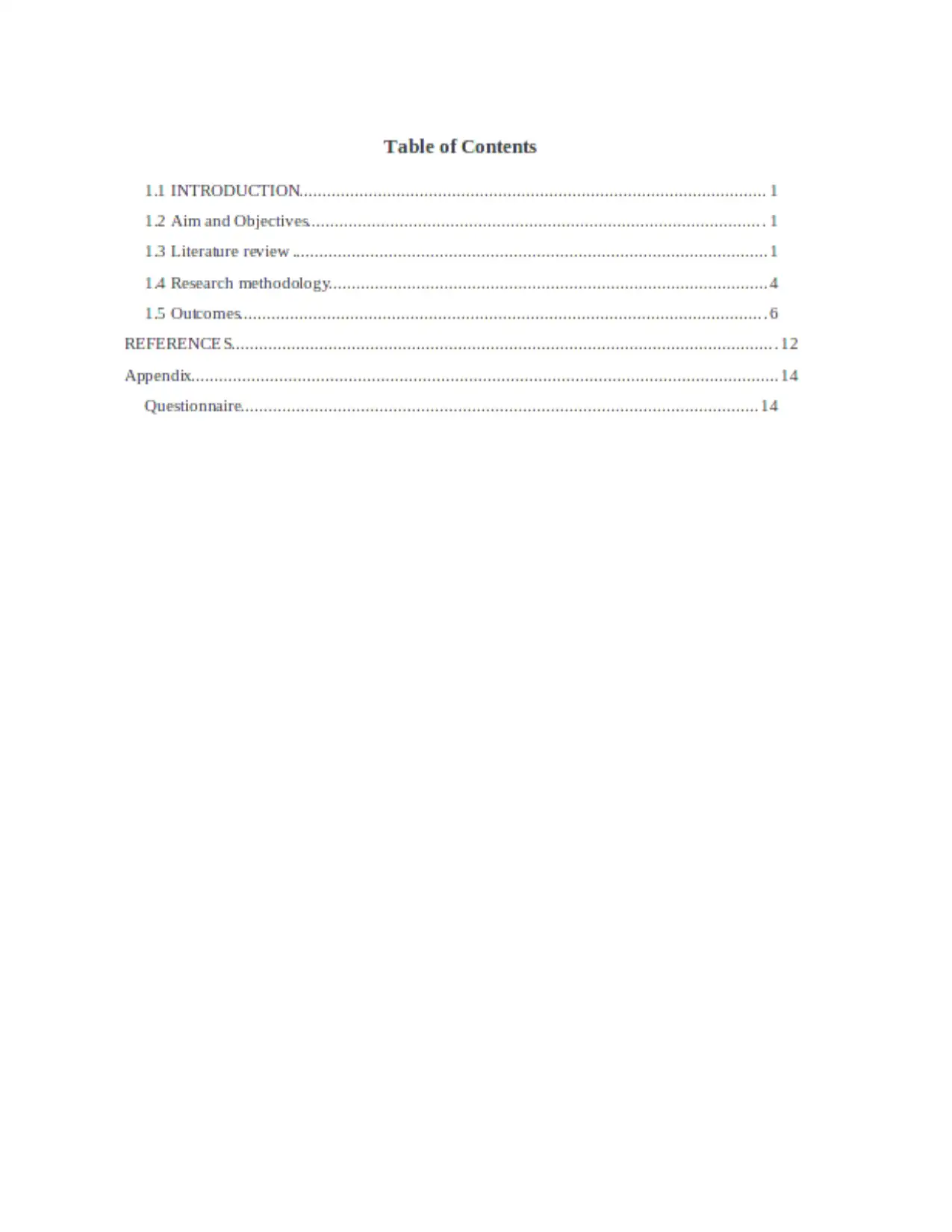
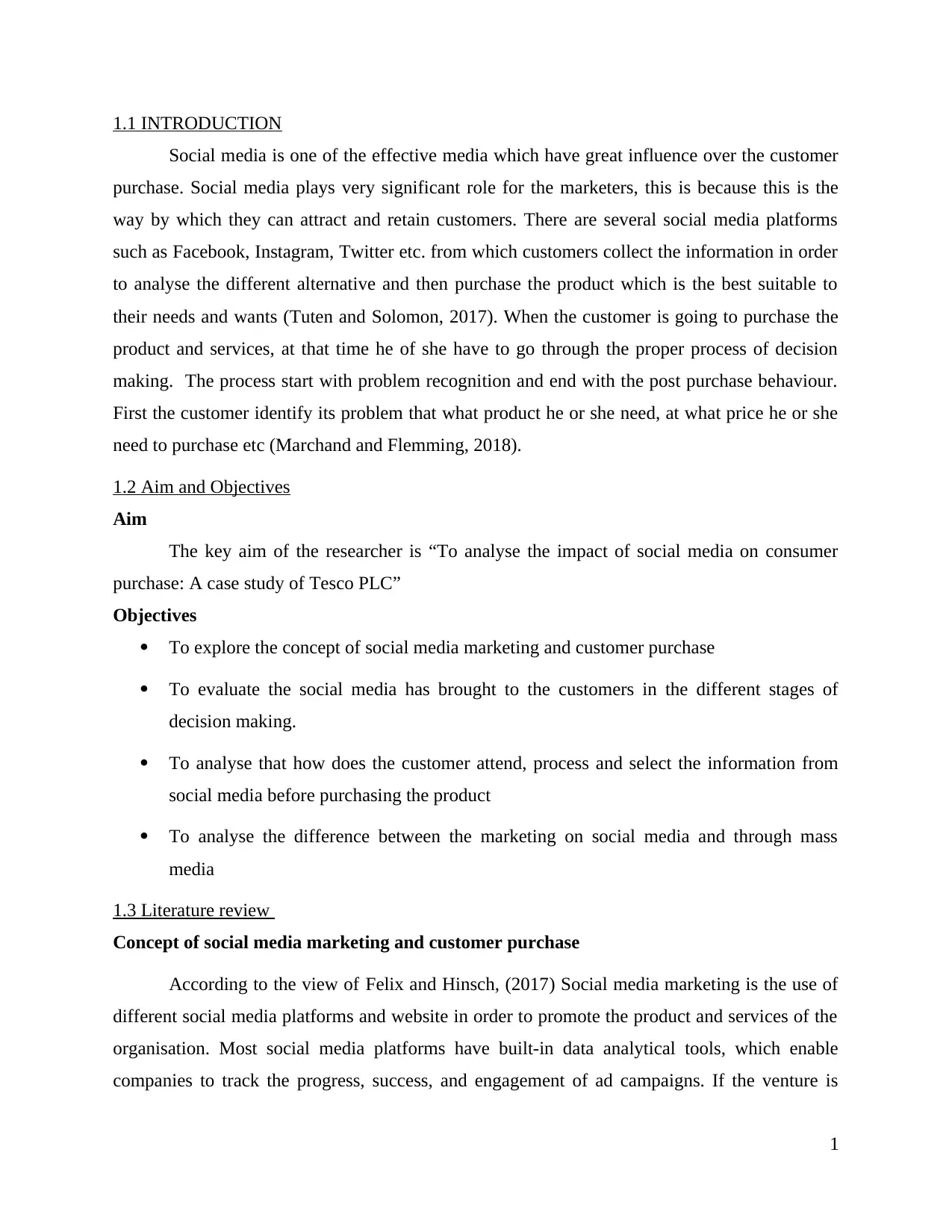
1.1 INTRODUCTION
Social media is one of the effective media which have great influence over the customer
purchase. Social media plays very significant role for the marketers, this is because this is the
way by which they can attract and retain customers. There are several social media platforms
such as Facebook, Instagram, Twitter etc. from which customers collect the information in order
to analyse the different alternative and then purchase the product which is the best suitable to
their needs and wants (Tuten and Solomon, 2017). When the customer is going to purchase the
product and services, at that time he of she have to go through the proper process of decision
making. The process start with problem recognition and end with the post purchase behaviour.
First the customer identify its problem that what product he or she need, at what price he or she
need to purchase etc (Marchand and Flemming, 2018).
1.2 Aim and Objectives
Aim
The key aim of the researcher is “To analyse the impact of social media on consumer
purchase: A case study of Tesco PLC”
Objectives
To explore the concept of social media marketing and customer purchase
To evaluate the social media has brought to the customers in the different stages of
decision making.
To analyse that how does the customer attend, process and select the information from
social media before purchasing the product
To analyse the difference between the marketing on social media and through mass
media
1.3 Literature review
Concept of social media marketing and customer purchase
According to the view of Felix and Hinsch, (2017) Social media marketing is the use of
different social media platforms and website in order to promote the product and services of the
organisation. Most social media platforms have built-in data analytical tools, which enable
companies to track the progress, success, and engagement of ad campaigns. If the venture is
1
Social media is one of the effective media which have great influence over the customer
purchase. Social media plays very significant role for the marketers, this is because this is the
way by which they can attract and retain customers. There are several social media platforms
such as Facebook, Instagram, Twitter etc. from which customers collect the information in order
to analyse the different alternative and then purchase the product which is the best suitable to
their needs and wants (Tuten and Solomon, 2017). When the customer is going to purchase the
product and services, at that time he of she have to go through the proper process of decision
making. The process start with problem recognition and end with the post purchase behaviour.
First the customer identify its problem that what product he or she need, at what price he or she
need to purchase etc (Marchand and Flemming, 2018).
1.2 Aim and Objectives
Aim
The key aim of the researcher is “To analyse the impact of social media on consumer
purchase: A case study of Tesco PLC”
Objectives
To explore the concept of social media marketing and customer purchase
To evaluate the social media has brought to the customers in the different stages of
decision making.
To analyse that how does the customer attend, process and select the information from
social media before purchasing the product
To analyse the difference between the marketing on social media and through mass
media
1.3 Literature review
Concept of social media marketing and customer purchase
According to the view of Felix and Hinsch, (2017) Social media marketing is the use of
different social media platforms and website in order to promote the product and services of the
organisation. Most social media platforms have built-in data analytical tools, which enable
companies to track the progress, success, and engagement of ad campaigns. If the venture is
1
⊘ This is a preview!⊘
Do you want full access?
Subscribe today to unlock all pages.

Trusted by 1+ million students worldwide
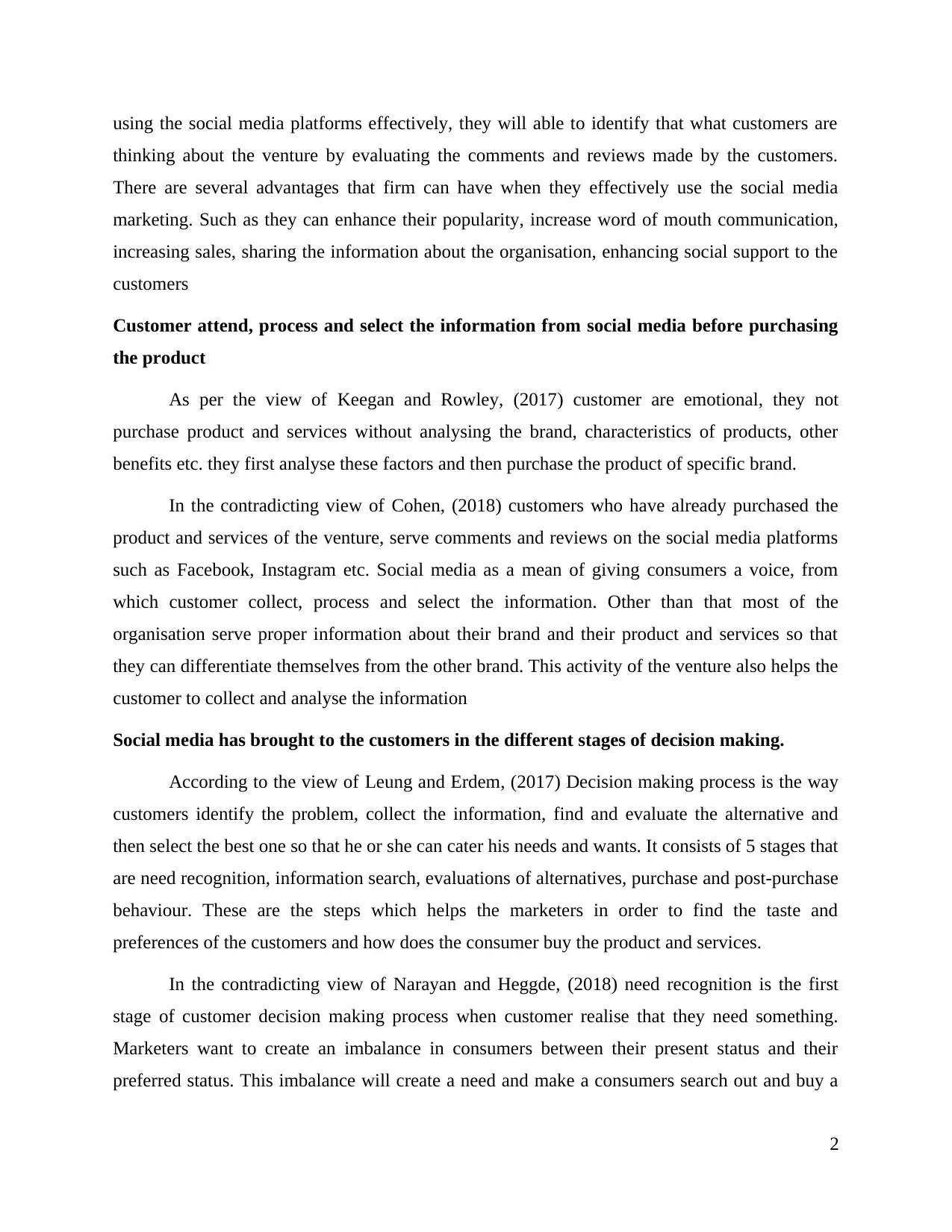
using the social media platforms effectively, they will able to identify that what customers are
thinking about the venture by evaluating the comments and reviews made by the customers.
There are several advantages that firm can have when they effectively use the social media
marketing. Such as they can enhance their popularity, increase word of mouth communication,
increasing sales, sharing the information about the organisation, enhancing social support to the
customers
Customer attend, process and select the information from social media before purchasing
the product
As per the view of Keegan and Rowley, (2017) customer are emotional, they not
purchase product and services without analysing the brand, characteristics of products, other
benefits etc. they first analyse these factors and then purchase the product of specific brand.
In the contradicting view of Cohen, (2018) customers who have already purchased the
product and services of the venture, serve comments and reviews on the social media platforms
such as Facebook, Instagram etc. Social media as a mean of giving consumers a voice, from
which customer collect, process and select the information. Other than that most of the
organisation serve proper information about their brand and their product and services so that
they can differentiate themselves from the other brand. This activity of the venture also helps the
customer to collect and analyse the information
Social media has brought to the customers in the different stages of decision making.
According to the view of Leung and Erdem, (2017) Decision making process is the way
customers identify the problem, collect the information, find and evaluate the alternative and
then select the best one so that he or she can cater his needs and wants. It consists of 5 stages that
are need recognition, information search, evaluations of alternatives, purchase and post-purchase
behaviour. These are the steps which helps the marketers in order to find the taste and
preferences of the customers and how does the consumer buy the product and services.
In the contradicting view of Narayan and Heggde, (2018) need recognition is the first
stage of customer decision making process when customer realise that they need something.
Marketers want to create an imbalance in consumers between their present status and their
preferred status. This imbalance will create a need and make a consumers search out and buy a
2
thinking about the venture by evaluating the comments and reviews made by the customers.
There are several advantages that firm can have when they effectively use the social media
marketing. Such as they can enhance their popularity, increase word of mouth communication,
increasing sales, sharing the information about the organisation, enhancing social support to the
customers
Customer attend, process and select the information from social media before purchasing
the product
As per the view of Keegan and Rowley, (2017) customer are emotional, they not
purchase product and services without analysing the brand, characteristics of products, other
benefits etc. they first analyse these factors and then purchase the product of specific brand.
In the contradicting view of Cohen, (2018) customers who have already purchased the
product and services of the venture, serve comments and reviews on the social media platforms
such as Facebook, Instagram etc. Social media as a mean of giving consumers a voice, from
which customer collect, process and select the information. Other than that most of the
organisation serve proper information about their brand and their product and services so that
they can differentiate themselves from the other brand. This activity of the venture also helps the
customer to collect and analyse the information
Social media has brought to the customers in the different stages of decision making.
According to the view of Leung and Erdem, (2017) Decision making process is the way
customers identify the problem, collect the information, find and evaluate the alternative and
then select the best one so that he or she can cater his needs and wants. It consists of 5 stages that
are need recognition, information search, evaluations of alternatives, purchase and post-purchase
behaviour. These are the steps which helps the marketers in order to find the taste and
preferences of the customers and how does the consumer buy the product and services.
In the contradicting view of Narayan and Heggde, (2018) need recognition is the first
stage of customer decision making process when customer realise that they need something.
Marketers want to create an imbalance in consumers between their present status and their
preferred status. This imbalance will create a need and make a consumers search out and buy a
2
Paraphrase This Document
Need a fresh take? Get an instant paraphrase of this document with our AI Paraphraser
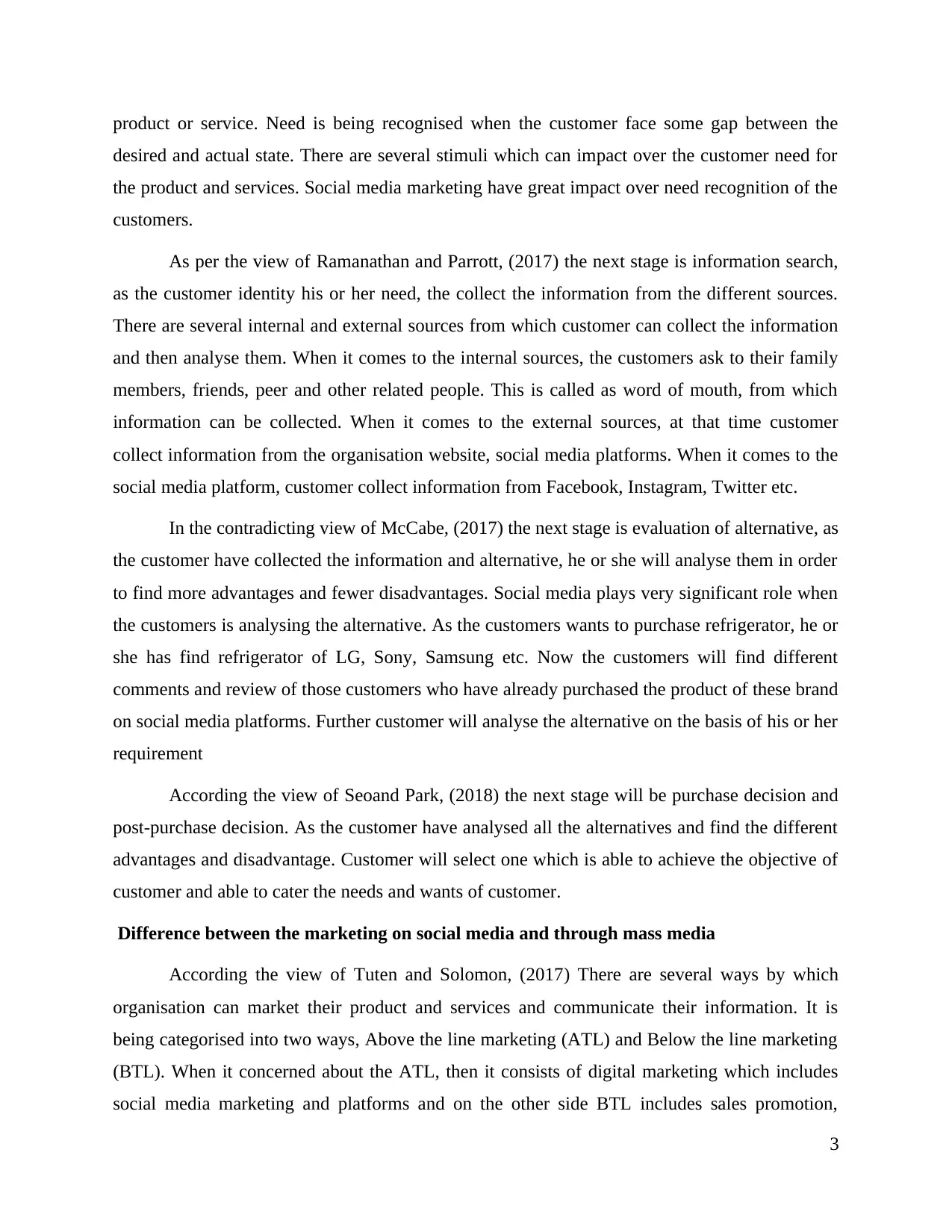
product or service. Need is being recognised when the customer face some gap between the
desired and actual state. There are several stimuli which can impact over the customer need for
the product and services. Social media marketing have great impact over need recognition of the
customers.
As per the view of Ramanathan and Parrott, (2017) the next stage is information search,
as the customer identity his or her need, the collect the information from the different sources.
There are several internal and external sources from which customer can collect the information
and then analyse them. When it comes to the internal sources, the customers ask to their family
members, friends, peer and other related people. This is called as word of mouth, from which
information can be collected. When it comes to the external sources, at that time customer
collect information from the organisation website, social media platforms. When it comes to the
social media platform, customer collect information from Facebook, Instagram, Twitter etc.
In the contradicting view of McCabe, (2017) the next stage is evaluation of alternative, as
the customer have collected the information and alternative, he or she will analyse them in order
to find more advantages and fewer disadvantages. Social media plays very significant role when
the customers is analysing the alternative. As the customers wants to purchase refrigerator, he or
she has find refrigerator of LG, Sony, Samsung etc. Now the customers will find different
comments and review of those customers who have already purchased the product of these brand
on social media platforms. Further customer will analyse the alternative on the basis of his or her
requirement
According the view of Seoand Park, (2018) the next stage will be purchase decision and
post-purchase decision. As the customer have analysed all the alternatives and find the different
advantages and disadvantage. Customer will select one which is able to achieve the objective of
customer and able to cater the needs and wants of customer.
Difference between the marketing on social media and through mass media
According the view of Tuten and Solomon, (2017) There are several ways by which
organisation can market their product and services and communicate their information. It is
being categorised into two ways, Above the line marketing (ATL) and Below the line marketing
(BTL). When it concerned about the ATL, then it consists of digital marketing which includes
social media marketing and platforms and on the other side BTL includes sales promotion,
3
desired and actual state. There are several stimuli which can impact over the customer need for
the product and services. Social media marketing have great impact over need recognition of the
customers.
As per the view of Ramanathan and Parrott, (2017) the next stage is information search,
as the customer identity his or her need, the collect the information from the different sources.
There are several internal and external sources from which customer can collect the information
and then analyse them. When it comes to the internal sources, the customers ask to their family
members, friends, peer and other related people. This is called as word of mouth, from which
information can be collected. When it comes to the external sources, at that time customer
collect information from the organisation website, social media platforms. When it comes to the
social media platform, customer collect information from Facebook, Instagram, Twitter etc.
In the contradicting view of McCabe, (2017) the next stage is evaluation of alternative, as
the customer have collected the information and alternative, he or she will analyse them in order
to find more advantages and fewer disadvantages. Social media plays very significant role when
the customers is analysing the alternative. As the customers wants to purchase refrigerator, he or
she has find refrigerator of LG, Sony, Samsung etc. Now the customers will find different
comments and review of those customers who have already purchased the product of these brand
on social media platforms. Further customer will analyse the alternative on the basis of his or her
requirement
According the view of Seoand Park, (2018) the next stage will be purchase decision and
post-purchase decision. As the customer have analysed all the alternatives and find the different
advantages and disadvantage. Customer will select one which is able to achieve the objective of
customer and able to cater the needs and wants of customer.
Difference between the marketing on social media and through mass media
According the view of Tuten and Solomon, (2017) There are several ways by which
organisation can market their product and services and communicate their information. It is
being categorised into two ways, Above the line marketing (ATL) and Below the line marketing
(BTL). When it concerned about the ATL, then it consists of digital marketing which includes
social media marketing and platforms and on the other side BTL includes sales promotion,
3
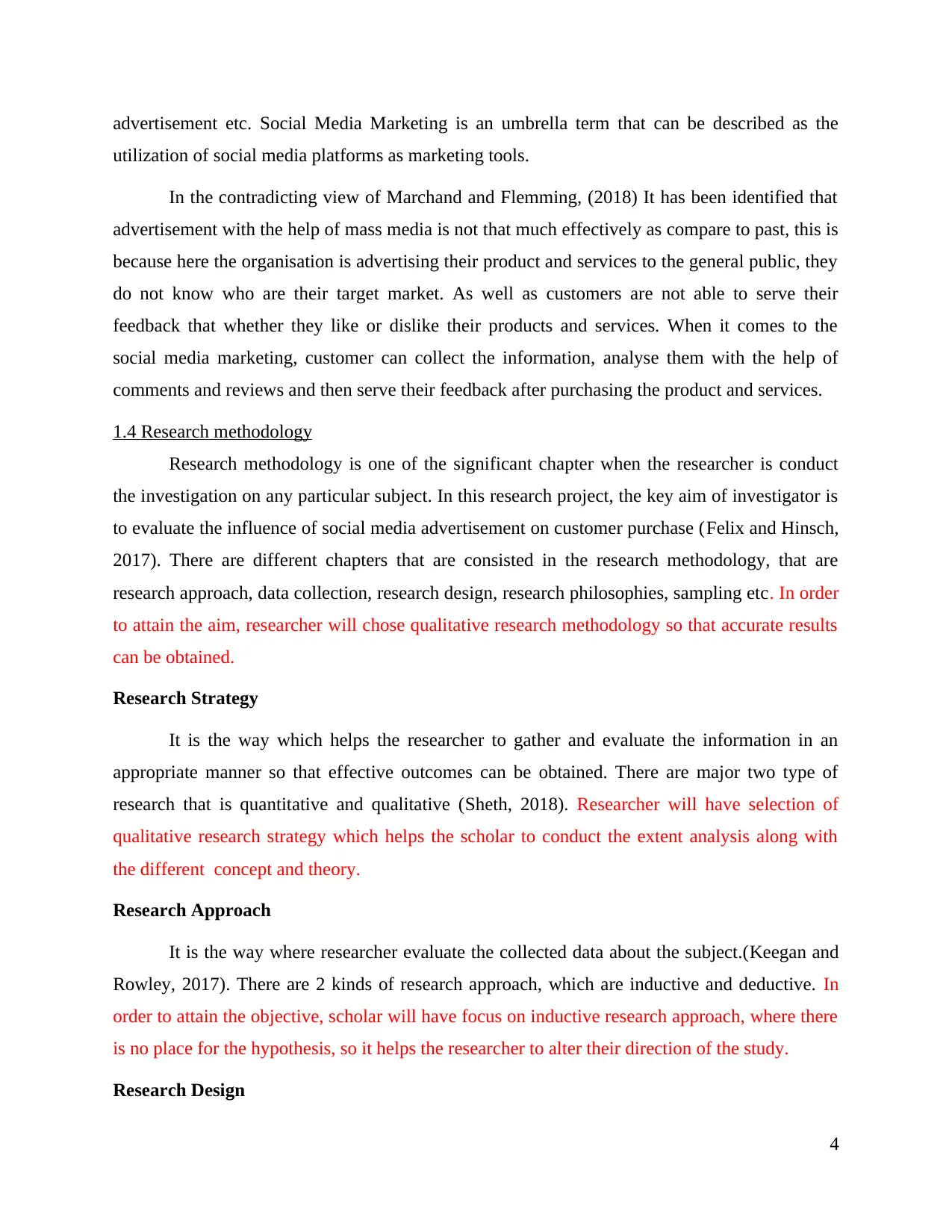
advertisement etc. Social Media Marketing is an umbrella term that can be described as the
utilization of social media platforms as marketing tools.
In the contradicting view of Marchand and Flemming, (2018) It has been identified that
advertisement with the help of mass media is not that much effectively as compare to past, this is
because here the organisation is advertising their product and services to the general public, they
do not know who are their target market. As well as customers are not able to serve their
feedback that whether they like or dislike their products and services. When it comes to the
social media marketing, customer can collect the information, analyse them with the help of
comments and reviews and then serve their feedback after purchasing the product and services.
1.4 Research methodology
Research methodology is one of the significant chapter when the researcher is conduct
the investigation on any particular subject. In this research project, the key aim of investigator is
to evaluate the influence of social media advertisement on customer purchase (Felix and Hinsch,
2017). There are different chapters that are consisted in the research methodology, that are
research approach, data collection, research design, research philosophies, sampling etc. In order
to attain the aim, researcher will chose qualitative research methodology so that accurate results
can be obtained.
Research Strategy
It is the way which helps the researcher to gather and evaluate the information in an
appropriate manner so that effective outcomes can be obtained. There are major two type of
research that is quantitative and qualitative (Sheth, 2018). Researcher will have selection of
qualitative research strategy which helps the scholar to conduct the extent analysis along with
the different concept and theory.
Research Approach
It is the way where researcher evaluate the collected data about the subject.(Keegan and
Rowley, 2017). There are 2 kinds of research approach, which are inductive and deductive. In
order to attain the objective, scholar will have focus on inductive research approach, where there
is no place for the hypothesis, so it helps the researcher to alter their direction of the study.
Research Design
4
utilization of social media platforms as marketing tools.
In the contradicting view of Marchand and Flemming, (2018) It has been identified that
advertisement with the help of mass media is not that much effectively as compare to past, this is
because here the organisation is advertising their product and services to the general public, they
do not know who are their target market. As well as customers are not able to serve their
feedback that whether they like or dislike their products and services. When it comes to the
social media marketing, customer can collect the information, analyse them with the help of
comments and reviews and then serve their feedback after purchasing the product and services.
1.4 Research methodology
Research methodology is one of the significant chapter when the researcher is conduct
the investigation on any particular subject. In this research project, the key aim of investigator is
to evaluate the influence of social media advertisement on customer purchase (Felix and Hinsch,
2017). There are different chapters that are consisted in the research methodology, that are
research approach, data collection, research design, research philosophies, sampling etc. In order
to attain the aim, researcher will chose qualitative research methodology so that accurate results
can be obtained.
Research Strategy
It is the way which helps the researcher to gather and evaluate the information in an
appropriate manner so that effective outcomes can be obtained. There are major two type of
research that is quantitative and qualitative (Sheth, 2018). Researcher will have selection of
qualitative research strategy which helps the scholar to conduct the extent analysis along with
the different concept and theory.
Research Approach
It is the way where researcher evaluate the collected data about the subject.(Keegan and
Rowley, 2017). There are 2 kinds of research approach, which are inductive and deductive. In
order to attain the objective, scholar will have focus on inductive research approach, where there
is no place for the hypothesis, so it helps the researcher to alter their direction of the study.
Research Design
4
⊘ This is a preview!⊘
Do you want full access?
Subscribe today to unlock all pages.

Trusted by 1+ million students worldwide
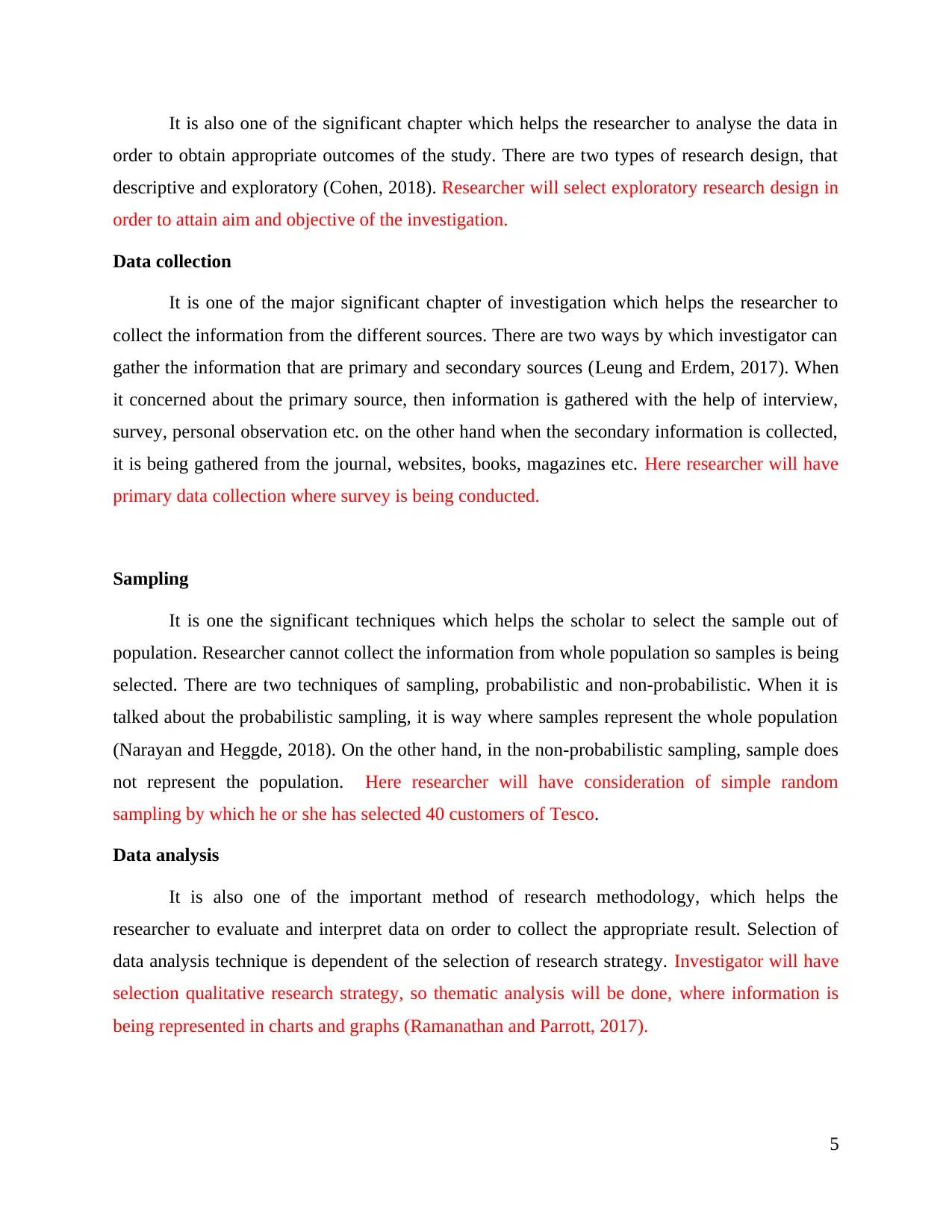
It is also one of the significant chapter which helps the researcher to analyse the data in
order to obtain appropriate outcomes of the study. There are two types of research design, that
descriptive and exploratory (Cohen, 2018). Researcher will select exploratory research design in
order to attain aim and objective of the investigation.
Data collection
It is one of the major significant chapter of investigation which helps the researcher to
collect the information from the different sources. There are two ways by which investigator can
gather the information that are primary and secondary sources (Leung and Erdem, 2017). When
it concerned about the primary source, then information is gathered with the help of interview,
survey, personal observation etc. on the other hand when the secondary information is collected,
it is being gathered from the journal, websites, books, magazines etc. Here researcher will have
primary data collection where survey is being conducted.
Sampling
It is one the significant techniques which helps the scholar to select the sample out of
population. Researcher cannot collect the information from whole population so samples is being
selected. There are two techniques of sampling, probabilistic and non-probabilistic. When it is
talked about the probabilistic sampling, it is way where samples represent the whole population
(Narayan and Heggde, 2018). On the other hand, in the non-probabilistic sampling, sample does
not represent the population. Here researcher will have consideration of simple random
sampling by which he or she has selected 40 customers of Tesco.
Data analysis
It is also one of the important method of research methodology, which helps the
researcher to evaluate and interpret data on order to collect the appropriate result. Selection of
data analysis technique is dependent of the selection of research strategy. Investigator will have
selection qualitative research strategy, so thematic analysis will be done, where information is
being represented in charts and graphs (Ramanathan and Parrott, 2017).
5
order to obtain appropriate outcomes of the study. There are two types of research design, that
descriptive and exploratory (Cohen, 2018). Researcher will select exploratory research design in
order to attain aim and objective of the investigation.
Data collection
It is one of the major significant chapter of investigation which helps the researcher to
collect the information from the different sources. There are two ways by which investigator can
gather the information that are primary and secondary sources (Leung and Erdem, 2017). When
it concerned about the primary source, then information is gathered with the help of interview,
survey, personal observation etc. on the other hand when the secondary information is collected,
it is being gathered from the journal, websites, books, magazines etc. Here researcher will have
primary data collection where survey is being conducted.
Sampling
It is one the significant techniques which helps the scholar to select the sample out of
population. Researcher cannot collect the information from whole population so samples is being
selected. There are two techniques of sampling, probabilistic and non-probabilistic. When it is
talked about the probabilistic sampling, it is way where samples represent the whole population
(Narayan and Heggde, 2018). On the other hand, in the non-probabilistic sampling, sample does
not represent the population. Here researcher will have consideration of simple random
sampling by which he or she has selected 40 customers of Tesco.
Data analysis
It is also one of the important method of research methodology, which helps the
researcher to evaluate and interpret data on order to collect the appropriate result. Selection of
data analysis technique is dependent of the selection of research strategy. Investigator will have
selection qualitative research strategy, so thematic analysis will be done, where information is
being represented in charts and graphs (Ramanathan and Parrott, 2017).
5
Paraphrase This Document
Need a fresh take? Get an instant paraphrase of this document with our AI Paraphraser
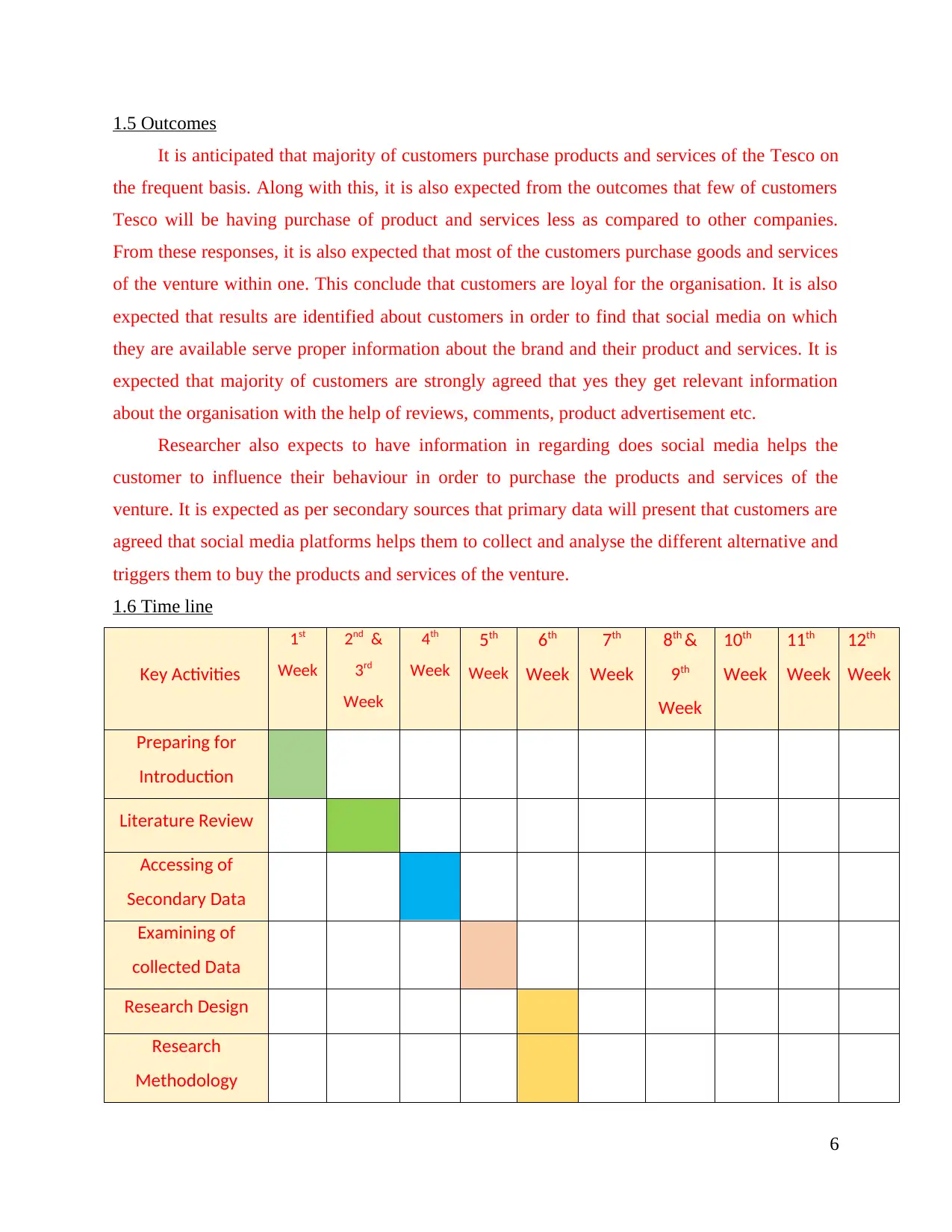
1.5 Outcomes
It is anticipated that majority of customers purchase products and services of the Tesco on
the frequent basis. Along with this, it is also expected from the outcomes that few of customers
Tesco will be having purchase of product and services less as compared to other companies.
From these responses, it is also expected that most of the customers purchase goods and services
of the venture within one. This conclude that customers are loyal for the organisation. It is also
expected that results are identified about customers in order to find that social media on which
they are available serve proper information about the brand and their product and services. It is
expected that majority of customers are strongly agreed that yes they get relevant information
about the organisation with the help of reviews, comments, product advertisement etc.
Researcher also expects to have information in regarding does social media helps the
customer to influence their behaviour in order to purchase the products and services of the
venture. It is expected as per secondary sources that primary data will present that customers are
agreed that social media platforms helps them to collect and analyse the different alternative and
triggers them to buy the products and services of the venture.
1.6 Time line
Key Activities
1st
Week
2nd &
3rd
Week
4th
Week
5th
Week
6th
Week
7th
Week
8th &
9th
Week
10th
Week
11th
Week
12th
Week
Preparing for
Introduction
Literature Review
Accessing of
Secondary Data
Examining of
collected Data
Research Design
Research
Methodology
6
It is anticipated that majority of customers purchase products and services of the Tesco on
the frequent basis. Along with this, it is also expected from the outcomes that few of customers
Tesco will be having purchase of product and services less as compared to other companies.
From these responses, it is also expected that most of the customers purchase goods and services
of the venture within one. This conclude that customers are loyal for the organisation. It is also
expected that results are identified about customers in order to find that social media on which
they are available serve proper information about the brand and their product and services. It is
expected that majority of customers are strongly agreed that yes they get relevant information
about the organisation with the help of reviews, comments, product advertisement etc.
Researcher also expects to have information in regarding does social media helps the
customer to influence their behaviour in order to purchase the products and services of the
venture. It is expected as per secondary sources that primary data will present that customers are
agreed that social media platforms helps them to collect and analyse the different alternative and
triggers them to buy the products and services of the venture.
1.6 Time line
Key Activities
1st
Week
2nd &
3rd
Week
4th
Week
5th
Week
6th
Week
7th
Week
8th &
9th
Week
10th
Week
11th
Week
12th
Week
Preparing for
Introduction
Literature Review
Accessing of
Secondary Data
Examining of
collected Data
Research Design
Research
Methodology
6
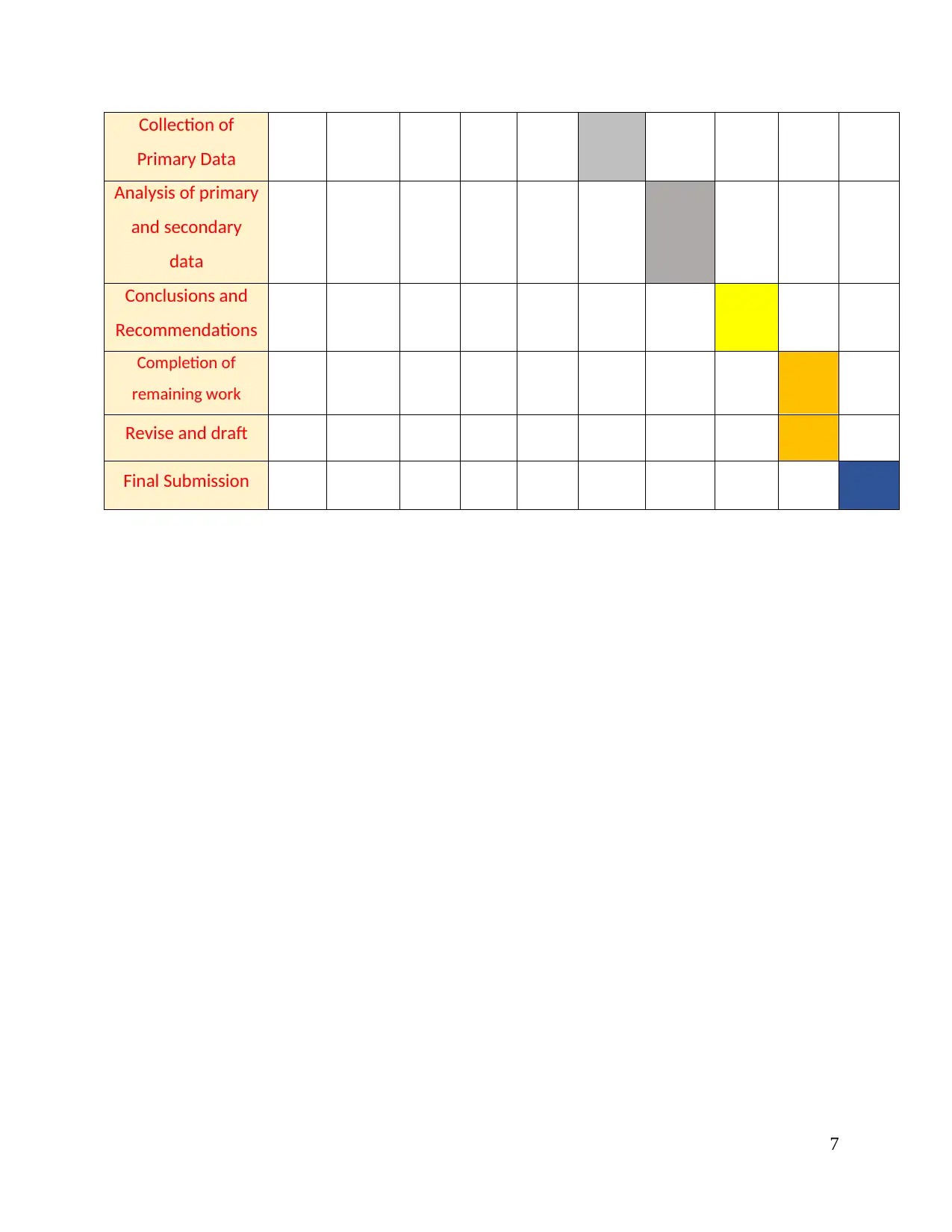
Collection of
Primary Data
Analysis of primary
and secondary
data
Conclusions and
Recommendations
Completion of
remaining work
Revise and draft
Final Submission
7
Primary Data
Analysis of primary
and secondary
data
Conclusions and
Recommendations
Completion of
remaining work
Revise and draft
Final Submission
7
⊘ This is a preview!⊘
Do you want full access?
Subscribe today to unlock all pages.

Trusted by 1+ million students worldwide
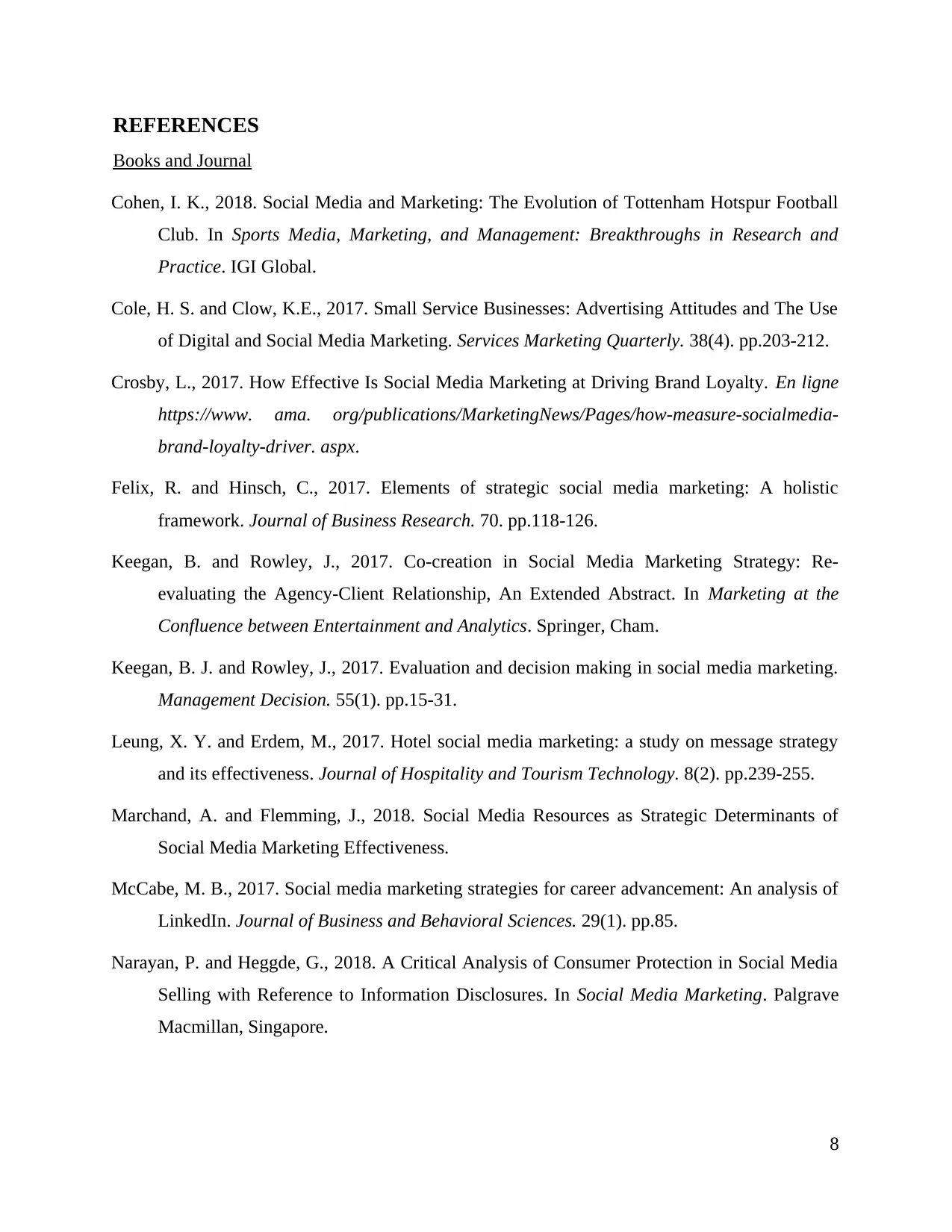
REFERENCES
Books and Journal
Cohen, I. K., 2018. Social Media and Marketing: The Evolution of Tottenham Hotspur Football
Club. In Sports Media, Marketing, and Management: Breakthroughs in Research and
Practice. IGI Global.
Cole, H. S. and Clow, K.E., 2017. Small Service Businesses: Advertising Attitudes and The Use
of Digital and Social Media Marketing. Services Marketing Quarterly. 38(4). pp.203-212.
Crosby, L., 2017. How Effective Is Social Media Marketing at Driving Brand Loyalty. En ligne
https://www. ama. org/publications/MarketingNews/Pages/how-measure-socialmedia-
brand-loyalty-driver. aspx.
Felix, R. and Hinsch, C., 2017. Elements of strategic social media marketing: A holistic
framework. Journal of Business Research. 70. pp.118-126.
Keegan, B. and Rowley, J., 2017. Co-creation in Social Media Marketing Strategy: Re-
evaluating the Agency-Client Relationship, An Extended Abstract. In Marketing at the
Confluence between Entertainment and Analytics. Springer, Cham.
Keegan, B. J. and Rowley, J., 2017. Evaluation and decision making in social media marketing.
Management Decision. 55(1). pp.15-31.
Leung, X. Y. and Erdem, M., 2017. Hotel social media marketing: a study on message strategy
and its effectiveness. Journal of Hospitality and Tourism Technology. 8(2). pp.239-255.
Marchand, A. and Flemming, J., 2018. Social Media Resources as Strategic Determinants of
Social Media Marketing Effectiveness.
McCabe, M. B., 2017. Social media marketing strategies for career advancement: An analysis of
LinkedIn. Journal of Business and Behavioral Sciences. 29(1). pp.85.
Narayan, P. and Heggde, G., 2018. A Critical Analysis of Consumer Protection in Social Media
Selling with Reference to Information Disclosures. In Social Media Marketing. Palgrave
Macmillan, Singapore.
8
Books and Journal
Cohen, I. K., 2018. Social Media and Marketing: The Evolution of Tottenham Hotspur Football
Club. In Sports Media, Marketing, and Management: Breakthroughs in Research and
Practice. IGI Global.
Cole, H. S. and Clow, K.E., 2017. Small Service Businesses: Advertising Attitudes and The Use
of Digital and Social Media Marketing. Services Marketing Quarterly. 38(4). pp.203-212.
Crosby, L., 2017. How Effective Is Social Media Marketing at Driving Brand Loyalty. En ligne
https://www. ama. org/publications/MarketingNews/Pages/how-measure-socialmedia-
brand-loyalty-driver. aspx.
Felix, R. and Hinsch, C., 2017. Elements of strategic social media marketing: A holistic
framework. Journal of Business Research. 70. pp.118-126.
Keegan, B. and Rowley, J., 2017. Co-creation in Social Media Marketing Strategy: Re-
evaluating the Agency-Client Relationship, An Extended Abstract. In Marketing at the
Confluence between Entertainment and Analytics. Springer, Cham.
Keegan, B. J. and Rowley, J., 2017. Evaluation and decision making in social media marketing.
Management Decision. 55(1). pp.15-31.
Leung, X. Y. and Erdem, M., 2017. Hotel social media marketing: a study on message strategy
and its effectiveness. Journal of Hospitality and Tourism Technology. 8(2). pp.239-255.
Marchand, A. and Flemming, J., 2018. Social Media Resources as Strategic Determinants of
Social Media Marketing Effectiveness.
McCabe, M. B., 2017. Social media marketing strategies for career advancement: An analysis of
LinkedIn. Journal of Business and Behavioral Sciences. 29(1). pp.85.
Narayan, P. and Heggde, G., 2018. A Critical Analysis of Consumer Protection in Social Media
Selling with Reference to Information Disclosures. In Social Media Marketing. Palgrave
Macmillan, Singapore.
8
Paraphrase This Document
Need a fresh take? Get an instant paraphrase of this document with our AI Paraphraser
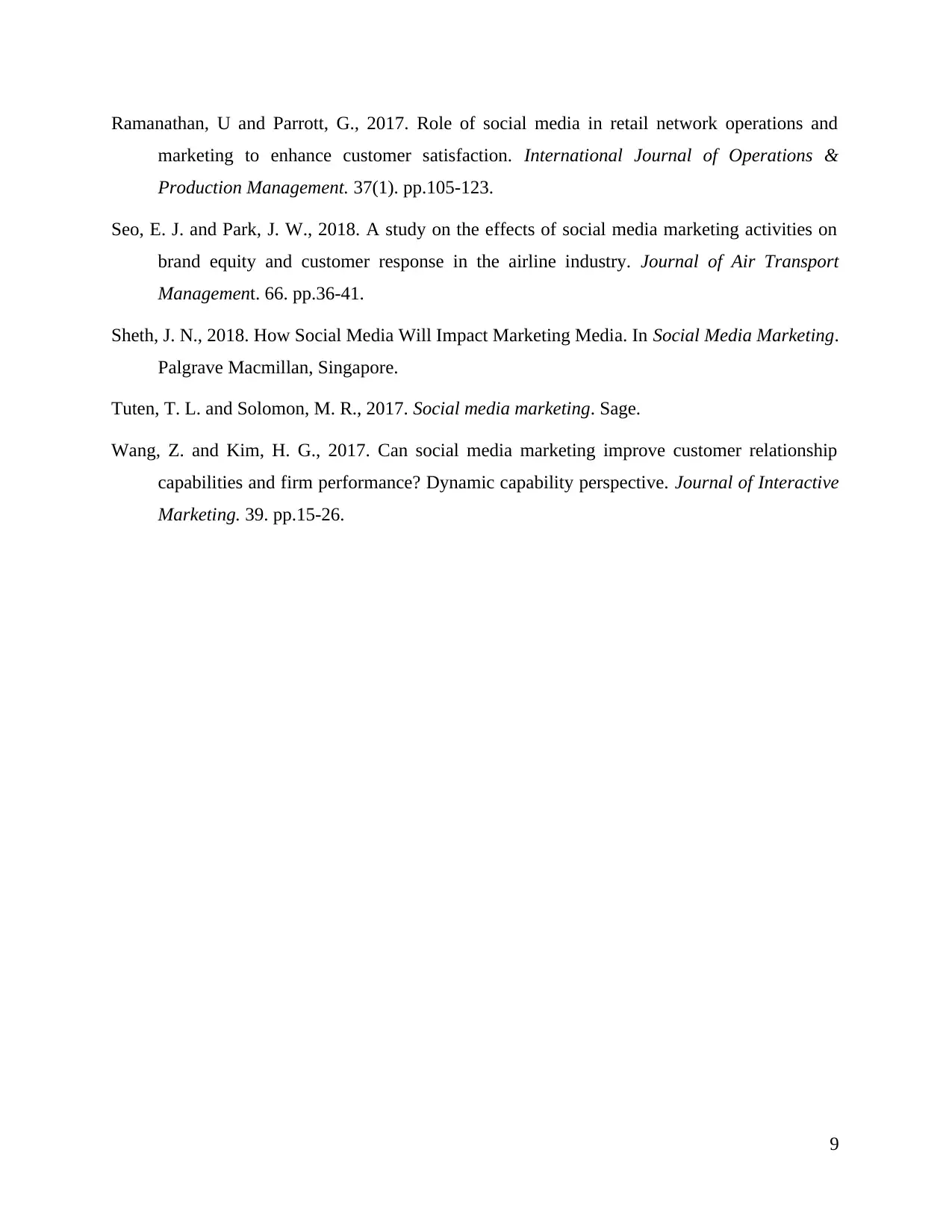
Ramanathan, U and Parrott, G., 2017. Role of social media in retail network operations and
marketing to enhance customer satisfaction. International Journal of Operations &
Production Management. 37(1). pp.105-123.
Seo, E. J. and Park, J. W., 2018. A study on the effects of social media marketing activities on
brand equity and customer response in the airline industry. Journal of Air Transport
Management. 66. pp.36-41.
Sheth, J. N., 2018. How Social Media Will Impact Marketing Media. In Social Media Marketing.
Palgrave Macmillan, Singapore.
Tuten, T. L. and Solomon, M. R., 2017. Social media marketing. Sage.
Wang, Z. and Kim, H. G., 2017. Can social media marketing improve customer relationship
capabilities and firm performance? Dynamic capability perspective. Journal of Interactive
Marketing. 39. pp.15-26.
9
marketing to enhance customer satisfaction. International Journal of Operations &
Production Management. 37(1). pp.105-123.
Seo, E. J. and Park, J. W., 2018. A study on the effects of social media marketing activities on
brand equity and customer response in the airline industry. Journal of Air Transport
Management. 66. pp.36-41.
Sheth, J. N., 2018. How Social Media Will Impact Marketing Media. In Social Media Marketing.
Palgrave Macmillan, Singapore.
Tuten, T. L. and Solomon, M. R., 2017. Social media marketing. Sage.
Wang, Z. and Kim, H. G., 2017. Can social media marketing improve customer relationship
capabilities and firm performance? Dynamic capability perspective. Journal of Interactive
Marketing. 39. pp.15-26.
9
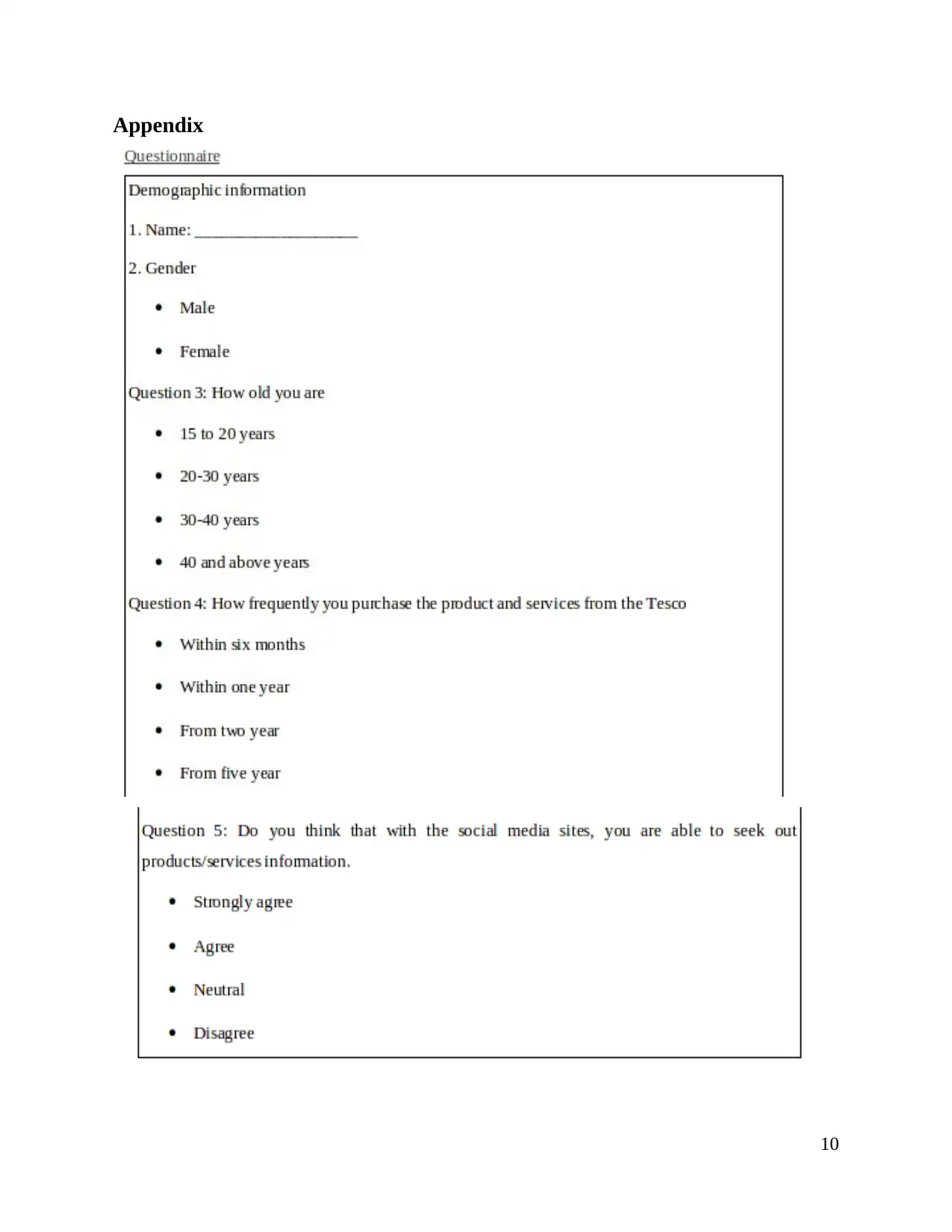
Appendix
10
10
⊘ This is a preview!⊘
Do you want full access?
Subscribe today to unlock all pages.

Trusted by 1+ million students worldwide
1 out of 13
Related Documents
Your All-in-One AI-Powered Toolkit for Academic Success.
+13062052269
info@desklib.com
Available 24*7 on WhatsApp / Email
![[object Object]](/_next/static/media/star-bottom.7253800d.svg)
Unlock your academic potential
Copyright © 2020–2025 A2Z Services. All Rights Reserved. Developed and managed by ZUCOL.





